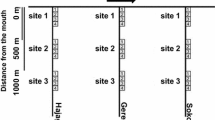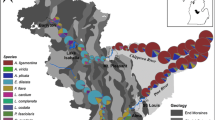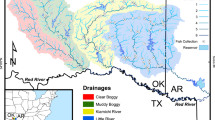Abstract
We used several techniques to analyze 10–11 collections from each of 13 stations along a mountain stream gradient to examine the hypothesis that there was a statistically significant (p < 0.05) uniform downstream gradient in benthic distribution. Random skewer techniques suggested that there was a significant downstream gradient of individuals per species, but only a weak gradient in species per station, and no gradient in functional guild composition. Ordination and clustering of either taxonomic or functional guild data suggested the existence of four longitudinally-defined groups of stations. Rarefaction curves also implied longitudinal groupings, with differences among groups implying species replacement than changes in organism numbers. Two species replacement indexes confirmed that suggestion. In summary, the distribution of the benthos in the creek may best be characterized as a punctuated gradient where gradual downstream changes in community composition are punctuated by sudden shifts to new community types. This punctuated gradient appears caused by changes in stream physical and chemical characteristics; the rapid nature of the changes hampers the interpretation of longitudinal analyses. Techniques such as random skewers and cluster analysis of rarefied samples will prove helpful in discerning pattern in stream benthos.
Similar content being viewed by others
References
Allen, J. D., 1974. The diversity and distributional ecology of benthic insects in Cement Creek, Colorado. Ecology 56: 1040–1053.
Allan, J. D., 1975. Faunal replacement and longitudinal zonation in an alpine stream. Verh. int. Ver. theor. angew. Limnol. 19: 1646–1652.
Bruns, D. A., G. W. Minshall, J. T. Brock, C. E. Cushing, K. W. Cummins & R. L. Vannote, 1982. Ordination of functional groups and organic matter parameters from the Middle Fork of the Salmon. River, Idaho. Freshwat. Invertebrate Biol. 1: 2–12.
Bruns, D. A., G. W. Minshall, C. E. Cushing, K. W. Cummins, J. T. Brock & R. L. Vannote, 1984. Tributaries as modifiers of the River Continuum Concept: analysis by polar ordination and regression models. Arch. Hydrobiol. 99: 208–210.
Culp, J. M. & R. W. Davies, 1982. Analysis of longitudinal zonation and the River Continuum Concept in the Oldman-South Saskatchewan River system. Can. J. Fish. aquat. Sci. 39: 1258–1266.
Cummins, K. W., 1974. Structure and function of stream ecosystems. BioScience 24: 631–641.
Cushing, C. E., C. D. McIntire, K. W. Cummins, G. W. Minshall, R. C. Petersen, J. R. Sedell & R. L. Vannote, 1983. Relationships among chemical, physical, and biological indices along a river continuum based on multivariate analyses. Arch. Hydrobiol. 98: 317–326.
Frost, S. A., A. Huni & W. E. Kershaw, 1971. Evaluation of a kicking technique for sampling stream bottom fauna. Can. J. Zool. 49: 167–173.
Gibon, F. M. & B. Statzner, 1985. Longitudinal zonation of lotic insects in the Bandama River system (Ivory Coast). Hydrobiologia 122: 61–64.
Hurlbert, S. H., 1971. The non-concept of species diversity: A critique and some alternative parameters. Ecology 59: 67–77.
Hynes, H. B. N., 1970. The ecology of running waters. University of Toronto Press, 555 pp.
Kershaw, W. E., T. R. Williams, S. A. Frost, R. A. Matchett, M. L. Mills & R. D. Johnson, 1968. The selective control of Simulium larvae by particulate insecticides and its significance in river management. Trans. R. Soc. Trop. Med. Hyg. 62: 35–40.
Lotspeich, F. B., 1980. Watersheds as the basic ecosystem: this conceptual framework provides a basis for a natural classification system. Wat. Resour. Bull. 16: 581–586.
Macan, T. T., 1961. A review of running water studies. Verh. int. Ver. theor. angew. Limnol. 14: 587–602.
Merritt, R. W. & K. W. Cummins, 1984. Introduction to the aquatic insects of North America, 2nd Edn. Kendall Hunt Publications, Dubuque IA, 722 pp.
Miller, C., 1985. Correlates of habitat favourability for benthic macroinvertebrates at five stream sites in an Appalachian Mountain drainage basin, U.S.A. Freshwat. Biol. 15: 709–733.
Minshall, G. W., R. C. Petersen, K. W. Cummins, T. L. Bott, J. R. Sedell, C. E. Cushing & R. L. Vannote, 1983. Interbiome comparison of stream ecosystem dynamics. Ecol. Monogr. 51: 1–25.
Minshall, G. W., K. W. Cummins, R. C. Petersen, C. E. Gushing, D. A. Bruns, J. R. Sedell & R. L. Vannote, 1985. Developments in stream ecosystem theory. Can. J. Fish. aquat. Sci. 42: 1045–1055.
Moss, W. W., 1968. Experiments with various techniques of numerical taxonomy. System. Zool. 17: 31–35.
Orloci, L., E. Feoli & P. Fewster, 1978. Multivariate analysis of vegetation data. University of Western Ontario, London, 179 pp.
Pielou, E. C., 1984. Probing multivariate data with random skewers: a preliminary to direct gradient analysis. Oikos 42: 161–165.
Sanders, H. L., 1968. Marine benthic diversity: a comparative study. Am. Nat. 102: 243–282.
Schaeffer, D. J., W. H. Ettinger, W. J. Tucker & H. W. Kerster, 1985. Evaluation of a community based index using benthic indicator organisms for classifying streams. J. Wat. Pollut. Contr. Fed. 57: 167–171.
Schaeffer, D. J. & J. A. Perry, 1986. Punctuated gradients and the distribution of riverine benthos. Freshwat. Biol. 16: 745–757.
Schopff, T. J. M., 1981. Punctuated equilibrium and evolutionary stasis. Paleobiology 7: 156–166.
Schopff, T. J. M., 1982. A critical assessment of punctuated equilibria, 1. Duration of taxa. Evolution 36: 1144–1157.
Simberloff, D., 1978. Use of rarefaction and related methods in ecology. In K. L. Dickson, J. Cairns Jr. & R. J. Livingston (eds), Biological Data in Water Pollution Assessment: Quantitative and Statistical Analyses. American Society for Testing and Materials, Philadelphia. Special Technical Publication 652, pp. 150–165.
Sneath, P. H. A. & R. R. Sokal, 1973. Numerical taxonomy. W. H. Freeman Co., San Francisco CA. 573 pp.
Statzner, B. & B. Higler, 1985. Questions and comments on the River Continuum Concept. Can. J. Fish. Aquat. Sci. 42: 1038–1044.
Storrey, A. W. & L. C. V. Pinder, 1985. Mesh-size and efficiency of sampling of larval Chironomidae. Hydrobiologia 124: 193–197.
Vannote, R. L., G. W. Minshall, K. W. Cummins, J. R. Sedell & C. E. Cushing, 1980. The River Continuum Concept. Can. J. Fish Aquat. Sci. 37: 130–137.
Whittaker, R. H., 1967. Gradient analysis of vegetation. Biol. Rev. 42: 207–264.
Wilhm, J. L., 1972. Graphic and mathematical analyses of biotic communities in polluted streams. Ann. Rev. Ent. 17: 223–252.
Zelt, K. A. & H. F. Clifford, 1972. Assessment of two mesh sizes for interpreting life cycles, standing crop, and percentage composition of stream insects. Freshwat. Biol. 2: 259–269.
Author information
Authors and Affiliations
Rights and permissions
About this article
Cite this article
Perry, J.A., Schaeffer, D.J. The longitudinal distribution of riverine benthos: A river dis-continuum?. Hydrobiologia 148, 257–268 (1987). https://doi.org/10.1007/BF00017528
Received:
Revised:
Accepted:
Published:
Issue Date:
DOI: https://doi.org/10.1007/BF00017528




